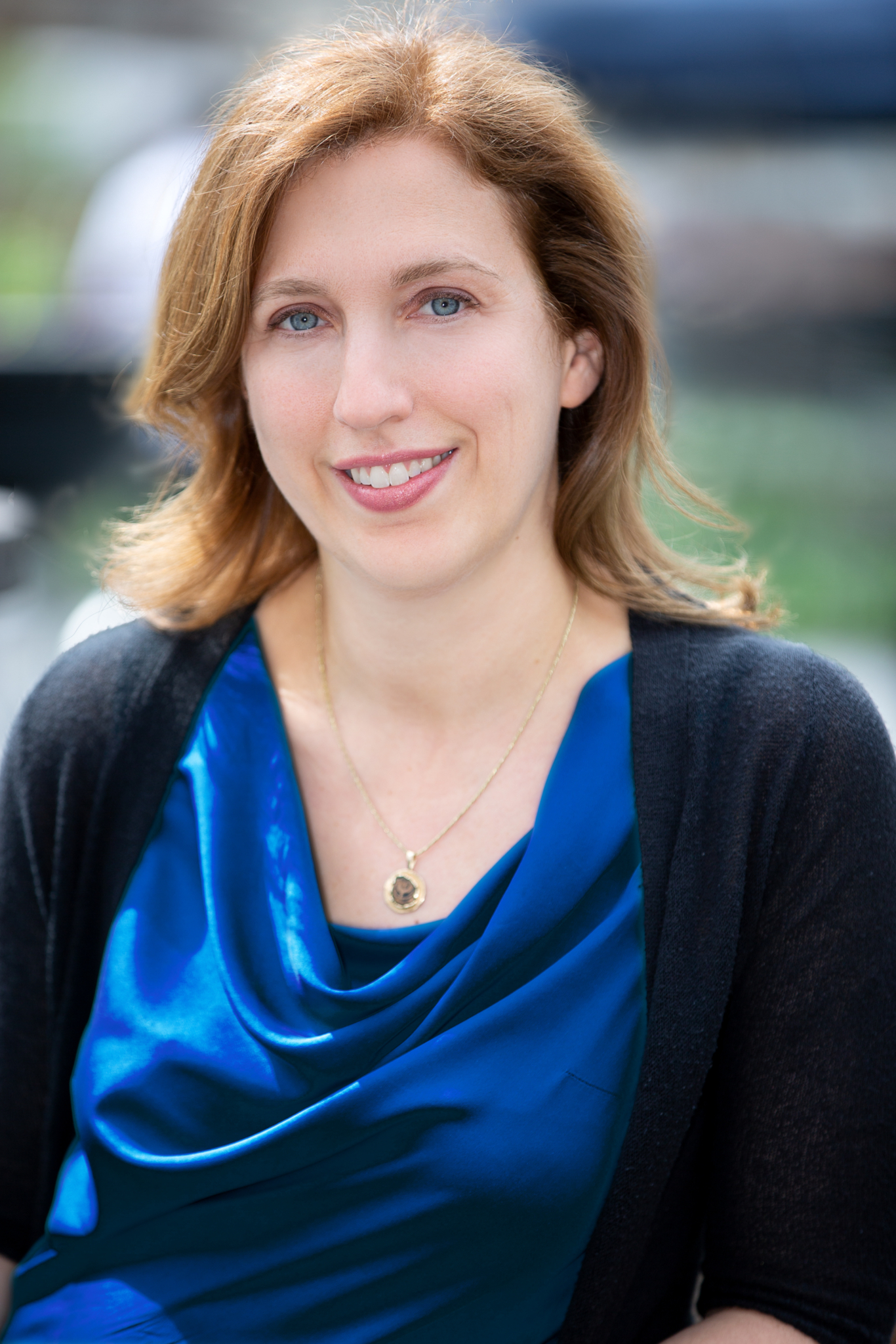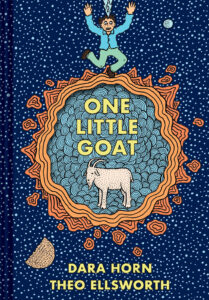Dara Horn‘s contributions to Jewish literature and education are inspiring. I was excited to learn she had written a middle-grade graphic novel and couldn’t wait to read it! ONE LITTLE GOAT (Norton Young Readers, 2025), illustrated by Theo Ellsworth, is an unexpected Passover story featuring a cheeky time-traveling goat. Young readers will be engaged while learning about Passover – and so much more. I always enjoy learning “the story behind the story,” and I’m especially fascinated by the way Dara connects all her books in such a meaningful way, no matter the genre. It’s an honor to share my interview with Dara about her journey creating ONE LITTLE GOAT.
Welcome, Dara!
ONE LITTLE GOAT is a delightful and deep graphic novel and quite a departure from your novels and nonfiction writing. Yet, you consider this the book the one you were “born to write.” Can you share a bit about this?
I can see how a graphic novel about a talking goat seems like a departure from my five novels for adults and especially from my previous book, the essay collection titled (gulp) People Love Dead Jews. Here’s the part where I blow your mind by telling you the truth: THEY ARE ALL THE SAME BOOK, and this one is the best one!
All of my books are about the past that animates the Jewish present. My five novels are all about contemporary Jewish life and the layers of the Jewish past that infuse it. I’ve used every possible mechanism to explore this idea in my books. I have a novel about a Jewish woman who has been alive for 2,000 years. I have a novel about a Jewish software developer who creates an app that records every minute of your life, in which the story then backs up to the discovery of a medieval Jewish document dump. I have a novel about the theft of a Chagall painting from a contemporary Jewish museum that then dives back into the life of Chagall and then back into the rabbinic folklore that inspired his work. People Love Dead Jews is exactly about the haunting aspects of contemporary antisemitism and its resonance with the past, and the serious problems with attempts to romanticize that past.
You see a pattern here. Everything I’m doing as an artist is an attempt to create portals to a past that resonates in the present, and to illuminate how our lives as Jews today are shaped by the choices of those who preceded us. All of my books are about how to access this deep historical consciousness that is at the heart of Jewish experience.
One Little Goat is simply the most straightforward, literal presentation of this idea. Because Passover itself is a deliberate enactment of that experience. The family in the book discovers that their Passover seder is sitting atop an archaeological tel of thousands of previous Passover seders, and that their seder is incomplete– literally— without those previous seders. They need a portal to that past in order to bring coherence to their present.
That is the actual situation of American Jews, and Passover itself is the portal. All I did in this book was make that story entirely literal. With the help of a talking goat.

In the book, a family is stuck at a seder for six months because they can’t find their afikomen, which is required to finish the seder. The Wise Child meets a rather sassy goat (from the Passover song) who takes him on a journey through time to find the afikomen. The story is filled with humor but also deals with history, family, faith, and the meaning of life. What do you hope young readers take away from the story?
There’s a lot of children’s literature that’s centered on the idea of a portal to a world that’s bigger than the child’s life– like the train platform in the Harry Potter books, or the wardrobe in the Narnia books– and even more children’s literature that’s centered on the idea more generally of an alternative universe beyond the obvious one. This is because children don’t have a lot of freedom. They’re figuring out who they are, and they are constantly looking for that escape route to a world that’s bigger than their own.
Passover actually offers people that escape route. It’s a reenactment of the ancient story of liberation from slavery, but we’re taught that liberation is an ongoing experience– in every generation we have to see ourselves as if we came out of Egypt, because there’s always some way in which we are still there. I remember feeling as a child as though the Passover seder was a moment when that portal opened, and being amazed that children were invited to enter first.
I hope every young person reading this book will see not only how much they are part of this story, how much this is their own story, but also how much this story depends on them.
The format of a graphic novel is unique. Did you face any unique challenges writing the manuscript?
I conceived of this book in graphic novel form, which is completely new for me. I wrote it with “stage directions” for the cartoonist, but the process of bringing it to life wound up being much more collaborative than I initially imagined. I also hadn’t fully appreciated how economical the language needs to be. It’s the ultimate in show-don’t-tell. The original manuscript had a lot more narrative writing– that is, language that wasn’t dialogue, but was just expository, introducing characters or scenes the way I might write it in a normal novel. Very little of that made it to the final version, because it turned out to be unnecessary.

Can you tell me a bit about your partnership with illustrator Theo Ellsworth? What were your thoughts when you first saw the art for the book? (Note: I love the illustrations, which seem to be an homage to Marc Chagall.)
My children introduced me to the indie cartoonist Theo Ellsworth, and now I’m the beneficiary of his brilliant imagination. A few years ago we stopped in a comics shop on a family road trip and my four kids came out with armloads of graphic novels– and in the car they were fighting over Ellsworth’s graphic novel Capacity. So I borrowed it to see what the fuss was about and came away utterly enchanted by his drawings.
Ellsworth’s work is super-detailed and amazingly imaginative, turning figurative ideas literal with a kind of cheeky surrealism. I’d been kicking around this Passover idea, and I just cold-contacted him about it. He isn’t Jewish and wasn’t familiar with Passover traditions, but he was completely game to dive in. When I first saw his images from the first two chapters— that hilarious opening image of the boy’s bearded skeleton at the “endless” seder (so familiar…), but especially at the very end of Chapter 1, when the goat appears and it’s suddenly revealed that the world has fallen out from underneath the house…. or when he illustrates the “knocks” on the door, or that stunning portal built out of toys… or what he does with all the doors to all the previous seders, the Alice-in-Wonderland vibe of this magical surreal situation of entering the past…. I mean, my heart was on the floor.
Do you plan to write more graphic novels or books for young readers?
I would never have thought so before— this book was such a lark for me. But now that I see how amazing this process is, I’m already wondering whether I need to try something similar with other Jewish themes or stories. It’s just such an astounding way of inviting readers of all ages into unfamiliar worlds.
Thank you, Dara!
Dara Horn is the award-winning author of six books, including the People Love Dead Jews: Reports from a Haunted Present, a New York Times Notable book in 2001. One of Granta magazine’s Best Young American Novelists, she is the recipient of three National Jewish Book Awards, among other honors, and she was a finalist for the Kirkus Prize, the Wingate Prize, the Simpson Family Literary Prize, and the Carnegie Medal for Excellence in Fiction. Her nonfiction work has appeared in The New York Times, The Wall Street Journal, The Washington Post, The Atlantic, Smithsonian, Tablet, and The Jewish Review of Books, among many other publications. Horn received her doctorate in comparative literature from Harvard University, studying Yiddish and Hebrew. She currently serves as Creative Adviser for The Weitzman National Museum of American Jewish History. She lives in New Jersey with her family.